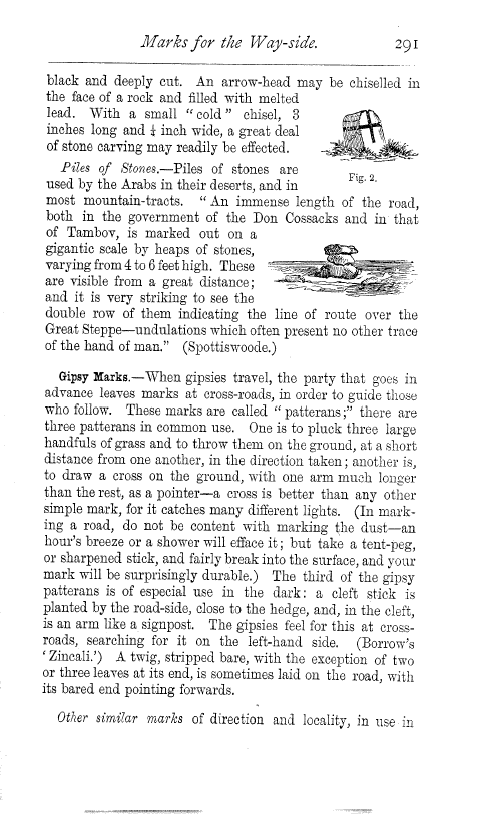Marks for the Way-side.
291
black and deeply cut. An arrow-head may be chiselled in the face of a rock and filled with melted lead. With a small "cold" chisel, 3 inches long and 4l inch wide, a great deal of stone carving may readily be effected.
Piles of Stones.-Piles of stones are
used by the Arabs in their deserts, and in
most mountain-tracts. " An immense length of the road, both in the government of the Don Cossacks and in that of Tambov, is marked out on a gigantic scale by heaps of stones, varying from 4 to 6 feet high. These are visible from a great distance; and it is very striking to see the
double row of them indicating the line of route over the Great Steppe-undulations which often present no other trace of the hand of man." (Spottiswoode.)
Gipsy Marks.-When gipsies travel, the party that goes in advance leaves marks at cross-roads, in order to guide those who follow. These marks are called "patterans ;" there are three patterans in common use. One is to pluck three large handfuls of grass and to throw them on the ground, at a short distance from one another, in the direction taken ; another is, to draw a cross on the ground, with one arm much longer than the rest, as a pointer-a cross is better than any other simple mark, for it catches many different lights. (In marking a road, do not be content with marking the dust-an hour's breeze or a shower will efface it ; but take a tent-peg, or sharpened stick, and fairly break into the surface, and your mark will be surprisingly durable.) The third of the gipsy patterans is of especial use in the dark : a cleft stick is planted by the road-side, close to the hedge, and, in the cleft, is an arm like a signpost. The gipsies feel for this at crossroads, searching for it on the left-hand side. (Borrow's ` Zincali.') A twig, stripped bare, with the exception of two or three leaves at its end, is sometimes laid on the road, with its bared end pointing forwards.
Other similar marks of direction and locality, in use in
Fig. 2.

